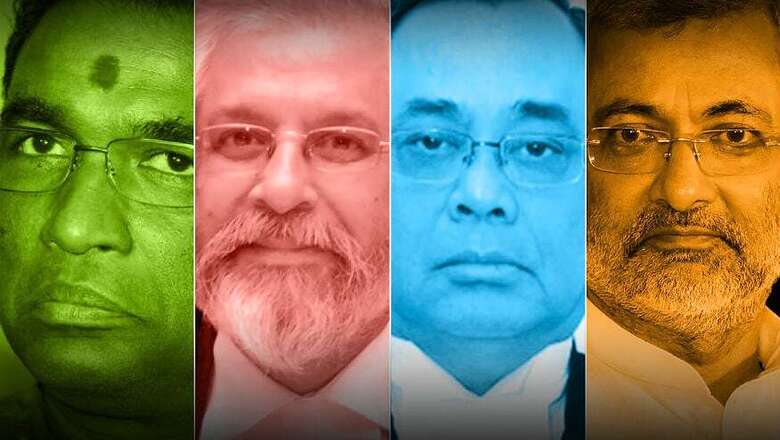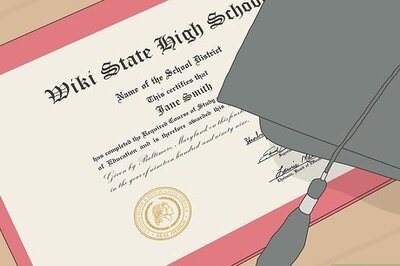
views
New Delhi: It is not everyday that sitting judges of the Supreme Court hold a press conference to highlight the issues concerning the judiciary.
Lashing out at the Chief Justice of India for an incorrect interpretation of the 'Master of the Roster theory' and stating that this media interaction was needed for them to discharge their debt towards the nation, the four senior-most judges have opened a Pandora’s box of unanswered questions.
News18 attempts to decode the tussle.
Who all addressed the media at the SC lawns on Friday?
In a judicial first, a media interaction was organised by the four senior-most judges of the Supreme Court of India. They were Justices Jasti Chelameswar, Ranjan Gogoi, Madan B Lokur and Kurian Joseph.
What did the Judges speak at the conference?
Justice Chelameswar who spoke on behalf of the judges said that they were compelled to call a press conference after noticing that the administration of the Apex court was not in order. They said that collective measures were taken to persuade the CJI to take remedial measures, but they "failed."
The judges stated that for the survival of the democracy, an independent and impartial probe is needed. The judges had met the CJI on Friday morning to discuss the issue but weren't able to convince him on certain aspects of bench formation.
The judges made it clear that they were not doing politics but had to take this step so that 20 years down the line wise men do not say that the four judges had sold their souls. The justices said that current situation was hampering the integrity of judiciary as an institution.
What was the basic content of the letter?
The judges had made it clear that the reason why this historic press conference was held would be contained in a letter written by the four judges to the Chief Justice of India.
The letter has attacked the theory of "CJI being the master of the roster" cited by the CJI while deciding benches.
The letter states that the "convention of recognising the privilege of the Chief Justice to form the roster and assign cases to different benches of this court is a convention devised for the efficient functioning of the court but it is not a recognition of any superior authority, legal or factual, over his colleagues."
Later, the four judges have also stated that "there have been instances with cases with far reaching consequences for the nation and institution has been assigned by the Chief Justice of this court selectively to the benches of their preferences without any rational basis for such assignments. This must be guarded against at all costs."
This has brought into the limelight the fact that judges are not pleased with the manner of benches being formed in the SC. Every case in the SC is heard by a bench of judges decided by the CJI so that the problem of "bench hunting" by the applicant does not arise and there is smooth functioning of the court.
Why is the 'master of the roster' theory being criticized?
In November 2017, after a dramatic exchange of arguments and war of words in the court room, the CJI led constitution bench had declared that the CJI is the master of the roster and established his dominance therein.
The 5 judge constitutional bench declared that it is the prerogative of the Chief Justice of India to decide what case has to be heard by which judge.
This order by the CJI-led-bench annulled an order passed by a two-judge bench led by Justice J. Chelameswar merely a day ago to constitute a bench of five senior most judges of the SC to hear a corruption case on November 13, 2017.
However, the CJI ruled that no one can ask him to form any bench.
In which corruption case did this theory arise? Was it felt that CJI should not be a part of the bench?
This was the medical college scam case. The FIR in the corruption case, investigated by the CBI, alleged that a conspiracy was hatched by certain persons, including a former Odisha HC judge and a hawala leader to bribe SC judges hearing the case of a debarred private medical college. CJI Mishra was leading the bench which had heard and decided the case of the medical college in question.
In its order, the constitution bench recorded that the CJI is indeed the first among equals on the judicial side, but on the administrative side, he is the master of the roster.
Now, this case arose from two separate petitions filed by Supreme Court advocate Kamini Jaiswal and NGO Campaign for Judicial Accountability and Reforms. Both petitions had sought an SIT probe into the corruption case. Both pleas said Chief Justice Misra should not be part of any proceedings, both administrative and judicial, in the case.
Justice Chelameswar's Bench, which heard Ms. Jaiswal's petition, found the allegations in the FIR “disturbing" and ordered a five-judge Constitution Bench to convene on November 13, but soon CJI Mishra constituted a separate bench and ruled the master of the roster doctrine.
This case was later dismissed by the CJI led bench and a cost of 25 lakhs was imposed on the petitioners.
Which are the recent cases where the CJI had formed benches which did not go down well with other judges?
Apart from the Medical college scam case, the other case where the composition of a bench was the bone of contention among the judges was the hearing of a plea seeking an independent probe into the death of Justice Loya.
Maharashtra-based journalist BR Lone filed an independent plea seeking a fair probe into the mysterious death of Loya, who was hearing the sensitive Sohrabuddin encounter case – in which various police officers and BJP President Amit Shah were named as parties.
A bench comprising Chief Justice Dipak Misra and Justices AM Khanwilkar and DY Chandrachud on 11 January, took note of the submission seeking an urgent hearing on the plea for a probe into Loya's death.
The CJI then formed a bench headed by Justice Arun Kumar Mishra to hear the case. However, there were murmurs that Justice Mishra should not be hearing the case.
But still, the bench as decided, heard the case today and termed it a "serious matter." The top court said, "This matter requires bi-party hearing rather than exparte".
A bench of Justices Arun Mishra and M M Shantanagoudar asked Maharashtra Government counsel Nishant R Katneshwarkar to file the reply by January 15.
Is there dissent among the Collegium members?
The Collegium system is one where the Chief Justice of India and a forum of four senior-most judges of the Supreme Court recommend appointments and transfers of judges. However, it has no place in the Indian Constitution. The system was evolved through Supreme Court judgments in the three judge's case (October 28, 1998).
Now cracks started appearing in the Collegium when in August last year, Justice J Chelameswar, the second senior-most SC judge who was part of both collegiums — for selection of SC judges and HC judges — had a war of words with Justice Khehar and reminded him of SC rulings about composition of the collegium when the CJI threatened to bypass him and extend the collegium.
In a letter to the CJI, Justice Chelameswar has spoken of how collegiums were selecting judges on personal requests of participants, and how successive CJIs had "treated members of the collegium as supplicants".
Later, when CJI Mishra took over the mantles from Khehar, in October 2017, CJI Mishra put up an agenda for the collegium's consideration stating that from now on all decisions of the Collegium along with the decisions would be made available online with reasons for elevation or non-elevation, so that transparency is maintained.
However, a few of the judges who addressed the media today, had echoed their dissent then.
Justice Lokur, Gogoi and Joseph had then said that it could not be a tool to indirectly harm the reputation of those who failed to meet the fluid suitability criteria. "Making public the decision to reject their names could be seen as an adverse personal remark on these judicial officers and advocates," said the justices then.
What is the Memorandum of Procedure?
In today's letter written by the four judges to the CJI, it has been stated that "there should be no further delay in finalising the memorandum of public procedure in the larger public interest. When the MOP was a subject matter of a constitution bench, it is difficult to understand as to how any other bench could have dealt with the matter."
This basically throws open the question on what is the MoP being referred to here is?
Now, Supreme Court judges are selected by the SC collegium – a body of India’s five top judges headed by the CJI.
The collegium sends its recommendations to the law ministry, which obtains a background check on the selected candidate from the Intelligence Bureau and a final nod from the Prime Minister’s Office, after which the appointment is notified.
In 2014, Parliament had passed the National Judicial Appointments Commission Act, which sought to end the two-decade-old practice of judges appointing judges through collegiums, but the SC struck it down as “unconstitutional" on October 16, 2015.
Later that year, the same bench, headed by Justice JS Khehar, ruled in favour of formulating a new MoP for greater transparency in appointment of judges. It asked the government to finalise the procedure “in consultation with the CJI".
However, the deadlock has never been over which had severely affected the appointment of judges. The judicial crunch could turn more severe with seven more SC judges, including Chief Justice of India (CJI) Dipak Misra, retiring this year. The earliest retirement – that of Justice Amitava Roy – will be on March 1.
Why is the MoP still stuck?
Union Minister of State for Law and Justice P.P. Chaudhary recently apprised the Parliament of the tussle between the Law Ministry and the government over the MoP.
The government highlighted the need for transparency, a separate secretariat, eligibility criteria and mechanism to deal with complaints. However, Collegium sent its finalised proposal on the draft on March 13, 2017, and dismissed the idea of a government veto on names recommended by the Collegium on grounds of national security.
Who will be the next CJI and when?
CJI Dipak Mishra would be in office till October 2, 2018. Justice Ranjan Gogoi, who was one of the dissenting judges to hold the press conference on Friday, would be in office till November 17, 2019, followed by Justice Sharad Arvind Bobde who would be in office until April 23, 2021.


















Comments
0 comment